The Wild White Goose: The Diary of a Female Zen Priest
Rev. Roshi P.T.N.H. Jiyu-Kennett
Shasta Abbey Press 2002
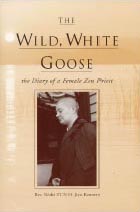 This
new, attractive edition of The Wild White Goose spans
a period of Jiyu-Kennett Roshi's life from her first two and
a half years as a junior Zen trainee, through her time in
Japan over the following six years, until she becomes a Zen
priest and teacher. She decided to write about her experience
to show spiritual aspirants "how training must be done in
the 'mud' of daily life in order to grow straight and strong
the stem of the lotus flower of his or her own spirituality."
Her story is very intriguing, one worth reading whatever path
you are drawn to.
This
new, attractive edition of The Wild White Goose spans
a period of Jiyu-Kennett Roshi's life from her first two and
a half years as a junior Zen trainee, through her time in
Japan over the following six years, until she becomes a Zen
priest and teacher. She decided to write about her experience
to show spiritual aspirants "how training must be done in
the 'mud' of daily life in order to grow straight and strong
the stem of the lotus flower of his or her own spirituality."
Her story is very intriguing, one worth reading whatever path
you are drawn to.
Rev. Jiyu-Kennett started as an angry young woman in England looking for the answers to her questions about
life, and eventually found self-acceptance and wisdom. She tells of her experience training in Japan, a setting
that was not used to having women or Westerners study there. By facing all the challenges, including the
language barrier, fundamentalism, prejudice and cultural differences, Kennett Roshi learned nonjudgement
of herself and others. "You do the best you can at all times: at every minute of the day you work like
mad on your own training to make yourself worthy of the master whom you have found." Her determination to
continue learning in difficult circumstances is an inspiration.
What interests me about Kennett Roshi is that she was one of the first Western women who went east on a
spiritual quest, in the early 1960s. She went in search of an answer to her question of why death and cruelty
exist. Many of her friends had died in World War II, and she wondered why she was still alive. Later she
refined her question to ask what caused selfishness in the first place: "Why am I as I am?" When Kennett
Roshi met her Zen teacher, she recognized him with a knowing so strong that nothing would deter her from
pursuing that path. She knew what she wanted. She was willing to face herself, see her mistakes, and keep
going until she became a full priest and teacher.
There are other Western women who searched, recognized and found their teachers in the east. Swami Radha and
Tenzin Palmo's stories have a similar ring to them. It is very encouraging to read about these women. Each of
them gave generously from her own experience and intense spiritual practices, offering Eastern spiritual
teachings in a way that the Western mind could understand. They have learned continuously, training to know
themselves. Rev. Jiyu-Kennett indicates that this training never ends: "Going, going, going on, always going
on never stopping, never resting, only continuing without doubt." These women teachers have put the effort
in to achieve the spiritual genius of compassion and love.
Rev. Jiyu-Kennett died in 1996. She had served twenty-six years as abbess and spiritual director of Shasta
Abbey, ordaining and teaching monks and laypeople.
Swami Radhananda
back to top
The Woman's Book of Yoga & Health: A Lifelong Guide to Wellness
Linda Sparrowe with Patricia Walden
Shambhala 2002
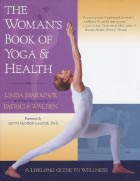 As
a new yoga teacher, I'm always looking for new resources.
When I found The Woman's Book of Yoga & Health at my
local bookstore, I had a feeling it would be an excellent
addition to my yoga library. Authors Linda Sparrowe and Patricia
Walden were the first attraction, and the foreword written
by restorative yoga authority Judith Hanson Lasater sealed
the deal.
As
a new yoga teacher, I'm always looking for new resources.
When I found The Woman's Book of Yoga & Health at my
local bookstore, I had a feeling it would be an excellent
addition to my yoga library. Authors Linda Sparrowe and Patricia
Walden were the first attraction, and the foreword written
by restorative yoga authority Judith Hanson Lasater sealed
the deal.
A glance at the table of contents confirms that the book speaks to women's health in all stages of life. Part one
provides three sequences of poses designed especially for women: there's an essential, an energizing and a restorative
sequence. Each includes detailed information about correct alignment and using props to maximize safety and effectiveness.
Supplementary sequences are introduced throughout the book. The authors recommend that women who are "fit and generally
healthy" use these three core sequences as is, interspersing them with other postures from supplementary sequences as
required.
But the book isn't just about sequences, valuable as they are. Every chapter includes in-depth discussions of health
issues faced by women in each phase of life. For example, part two tackles issues teenagers may face, such as body
image, while part five addresses concerns of older women, such as osteoporosis. Each discussion includes a section
describing "How Yoga Can Help," which brings the material from theory into practice.
Don't limit yourself to reading only the sections for your phase of life, though. You'll find information that's
of interest to you in all chapters. The book is especially helpful for those of us who teach. I have women of all
ages in my yoga classes, and this book helps me to appreciate and address their needs.
The authors wisely state that "knowing why we chose a pose will help you create your own routine." Giving the
reader responsibility for her practice is perhaps the book's most motivating message. This message is reinforced
by Judith Lasater: "The key is you. Without your full participation, this book remains a book on your shelf. You
can bring these practices to life; they will help you from the first moment you try them."
In other words, excellent resources like The Woman's Book of Yoga & Health can support your practice but
the key to an authentic practice is within you.
Elizabeth Rayson
back to top
The Unknown She: Eight Faces of an Emerging Consciousness
Hilary Hart
The Golden Sufi Center 2003
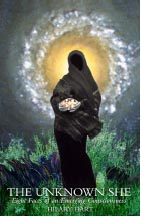 "Enter Her light and Her light will take you to the treasure. Enter this luminous blackness, and She who is
love itself will take you deeper and deeper into loveShe wants to be known!" Hilary Hart
Perhaps
the most remarkable aspect of Hilary Hart's exploration
of feminine aspects of higher consciousness is the author's
commitment to honour the diversity through which this emerging
power expresses itself. In The Unknown She, via interviews
with eight widely ranging contemporary mystics, Hart attempts
to clarify how the Divine feminine is finding new ways into
our modern world and into the lives of some lesser known
spiritual pioneers.
"Enter Her light and Her light will take you to the treasure. Enter this luminous blackness, and She who is
love itself will take you deeper and deeper into loveShe wants to be known!" Hilary Hart
Perhaps
the most remarkable aspect of Hilary Hart's exploration
of feminine aspects of higher consciousness is the author's
commitment to honour the diversity through which this emerging
power expresses itself. In The Unknown She, via interviews
with eight widely ranging contemporary mystics, Hart attempts
to clarify how the Divine feminine is finding new ways into
our modern world and into the lives of some lesser known
spiritual pioneers.
Hart herself has direct experience with the practices of Tibetan Buddhism and Naqshbandi Sufism. These
spiritual paths are represented in the book, along with Christianity, Zen, West African Shamanism and Lakota
Sioux spirituality. Traditionally male concepts of God are exchanged in the personal and sometimes profound
searches of the interview subjects. While the contributors come from diverse backgrounds, their experiences
share a common revelation, which, when glimpsed as a whole, reveal a portrait of a palpable universal force at
play in the world in simple yet striking ways.
The book is at times almost lyrically transporting, at other times conversational in tone.
These very human stories of Divine longing are infused with a humour and joy deeply felt as we accompany
each of the interviewees on their journeys. The Unknown She will leave readers with the sense of having
traveled vast distances only to realize what they have already known and felt in their hearts: that the feminine
spiritual principle is as active today as She has ever been, and that the world is in the process of an evolutionary
transformation through Her influence.
Michael Wray
back to top
boucha blue blazes
Alejandra and Aeron (A&A)
Orthlorng Musork 2002/2003
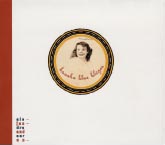 I have just started working in a music library, where the music
is organized into fifteen genres. This recording would be found
in the fifteenth genre: music actuelle, a name given to classify
music that is new and does not fit into other, more established
classifications.
I have just started working in a music library, where the music
is organized into fifteen genres. This recording would be found
in the fifteenth genre: music actuelle, a name given to classify
music that is new and does not fit into other, more established
classifications.
Alejandra Salinas and Aeron Bergman (A&A) work together and live in Spain. They make music and have established a record
label called lucky kitchen (www.luckykitchen.com). A&A are well known for their fine electronic works, field recordings
and critical thinking.
boucha blue blazes is their most recent release, dedicated to their grandmothers and yours. It features Boucha, Aeron's
grandmother, and was recorded over one holiday season in Spain. Boucha has been a singer all her life. She played the
lead role in the Detroit Conservatory's production of La Boheme and has been a soloist in choirs since the 1950s.
The very beautiful thing about this album is the gentle dynamic between the three musicians. The sounds themselves (voice,
electronics, guitar, piano) are deliberate and yet at no point do they feel forced or heavy. There is a lot of space
in the music they make together, creating an environment for imagination to play. What do Boucha's fingers look like as
she plays the piano? What is the view from the kitchen window? Is the house small and cozy as the sound suggests? What
colour is the living room?
As A&A take their places beside the grandmother, the optimism of old-time music blends with the optimism of new technology.
This album conveys an acceptance of the conditions of living on Earth sometimes sad, sometimes romantic, but always
alive. Two generations come together to blaze sounds.
Sara Torrie
back to top
Wanita
Rokia Traore
Label-Bleu-Indigo 2000
 At age twenty-eight, talented Malian singer Rokia Traore is quickly
gaining recognition in the world music scene. I had the honour of
seeing Rokia at the 2002 Vancouver Folk Music Festival, and it was
a deeply spiritual experience for me. Her music echoed across the
ocean and twilight sky, creating a magical moment. Rokia is a performer
with a huge heart, emotional depth, expansive social conscience
and phenomenal power. She brings the traditions and current issues
of her Bamanan culture to an international audience.
At age twenty-eight, talented Malian singer Rokia Traore is quickly
gaining recognition in the world music scene. I had the honour of
seeing Rokia at the 2002 Vancouver Folk Music Festival, and it was
a deeply spiritual experience for me. Her music echoed across the
ocean and twilight sky, creating a magical moment. Rokia is a performer
with a huge heart, emotional depth, expansive social conscience
and phenomenal power. She brings the traditions and current issues
of her Bamanan culture to an international audience.
On Wanita, her second recording, Rokia continues to work with traditional instruments from Mali that lend
an authentic, visceral feel to the music. The power of wanita (meaning "that which brings out human will
and determination") is reflected in the songs, which deal with the themes of gender inequality, the role
of women in Malian society, polygamy and African dignity. With the exception of one song, all the selections
are in her native language.
From the very first note, I was drawn in by the clarity, directness and sincere intent of the music.
Some tracks are compositions of stark simplicity and subtle beauty, while others burst into an
infectious groove. On the title track, Rokia is joined by kora virtuoso Toumani Diabate, who complements
the rich and pure cadence of her voice perfectly. The kora, a harp-like instrument, is a favourite of mine,
with a long tradition of its own, and to hear it teamed up with Rokia's voice is indeed a pleasure. Wanita
also includes a duet between Rokia and singer/guitarist Boubacar Traore. Boubacar is a legend in his own
right, and I can almost hear how much they are enjoying each other's musical company.
The musicianship and arrangements are excellent, but if the studio tracks lack a certain spontaneity,
that is more than made up for by the bonus CD. On this mini-disk containing two live selections, the
band bristles with energy and Rokia's voice bursts forth with great authority, exuberance and joy.
Wanita stands as a high-water mark from an emerging world-class artist. I hope to see and hear more
of Rokia Traore in the future.
Barry Livingston
back to top
Fierce Wisdom
Chloe Goodchild
Naked Voice Music 2002
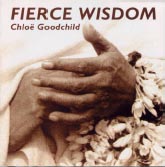 I first heard Chloe Goodchild's voice when she sang in the temple
at Yasodhara Ashram. Her arrival was a splendour of synchronicity,
concurring with the beginning of a Festival of Sound. The temple
is a white dome, perched above a large lake. The structure contains
sound in a way that amplifies harmonics and allows a new kind of
hearing to occur. Chloe's voice filled the temple that weekend,
and I still hear its echoes when I sing the melodies or chants that
I learned from her.
I first heard Chloe Goodchild's voice when she sang in the temple
at Yasodhara Ashram. Her arrival was a splendour of synchronicity,
concurring with the beginning of a Festival of Sound. The temple
is a white dome, perched above a large lake. The structure contains
sound in a way that amplifies harmonics and allows a new kind of
hearing to occur. Chloe's voice filled the temple that weekend,
and I still hear its echoes when I sing the melodies or chants that
I learned from her.
Hearing her voice on Fierce Wisdom evokes the memory of that first hearing, when I felt something melt inside me, touched
by the devotion and longing that permeated the sound she offered. These qualities enliven the pieces on this recording,
where a blend of vocals and instruments creates a rich soundscape. Chloe's voice, plus violin, piano, saxophone, bass
clarinet and percussion, weave textured musical patterns, a tapestry of varied tones, rhythms and harmonies.
The lyrics are poetic. They come from Chloe herself, from versions of Rumi's poems by Coleman Barks, and from Anandamayi
Ma (whose hands adorn the CD's cover and, says Chloe, "whose presence transformed my life"). Sometimes she creates
sounds without words, as when her voice is accompanied by a bass clarinet and a play of tone dances between them.
Other times, with just a simple phrase, Chloe's voice evokes a richness that feels like a transformation of the heart
is occurring.
Each track slides seamlessly into the next, yet the CD carries a surprising variety in the rhythms, instrumentation
and combinations. There are amazing drum, saxophone and guitar sequences. Some songs are tender, reflective and sweet.
When the piano involves itself, the songs are full of joy. At times, drums sound as if they come from the very centre
of creation. On another track, violin and voices evoke prayerful longing that merges in and out of a background drone,
reminding me of the underlying hum of creation. Chloe's harmonies create slow, loving expressions that, on one piece,
gradually expand into the increasingly varied rhythms of a five-string banjo.
Chloe's benediction on the inside cover "may compassion sound in us"
is given manifestation on this recording.
Alanda Greene
back to top